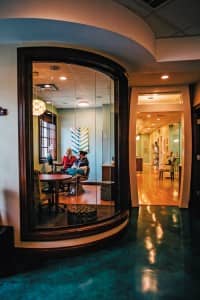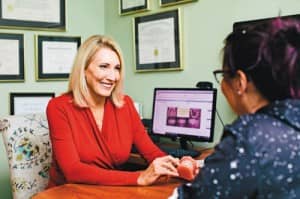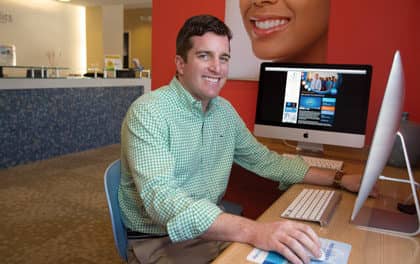What keeps you at the top of your game? For Louisville-based orthodontist Amy Farnsworth, DMD, it’s a network of colleagues and professional acquaintances that she can turn to, whether for advice on a treatment plan or recommendations on a new practice-management system.
The daughter of a career counselor, Farnsworth was advised early to explore careers that were aligned with her interests. In high school, that was science and healthcare. From there it was a question of a field that allowed her to balance career and family. In high school, she saw firsthand how a friend’s father who was an orthodontist was able to have that work-life balance. She wanted the same.
“I was lucky to figure that out early. I have friends from college that tease me still that say, ‘You’re the only person we knew that knew what they wanted to do when they got to college; and you actually stayed with it and did it’,” says Farnsworth, who completed her undergraduate degree at the University of Notre Dame.
 Forever Home
Forever Home
When it came time to actually do it, Farnsworth knew she wanted to do it on her own from the start—setting up a solo private practice right out of her residency at the University of Louisville. But an opportunity to help another orthodontist slightly tweaked her path.
“One of my instructors in the residency program was diagnosed with cancer right around the time I was graduating. I was looking to set up a private practice, but hadn’t yet made any commitments anywhere. He wasn’t looking specifically to bring anybody in at that time, but his diagnosis sort of forced it. So, he asked me to come in and be an associate. He had always intended to bring somebody in, so if he was able to come back to work that was how we were going to proceed—in an associateship.
“We worked together for about a week, and then he had to leave to pursue treatment for his cancer and was not able to come back to the practice.”
For a year and a half, before ultimately buying the practice, Farnsworth worked as an associate—although she was the only doctor working day to day. Through it all, the staff remained with Farnsworth, helping her through the transition.
That was 24 years ago.
Originally the practice had two locations—a main office and a satellite; but 8 years ago, Farnsworth made the decision to commit to building a single, larger office, buying and renovating a building in Louisville to house Farnsworth Orthodontics for decades to come. At that point, she knew exactly what she wanted. She had spent the previous 16 years renovating her original two offices to make them hers. She came to this last build with the insight to know the layout and design that would speak to the practice into which she wanted to welcome future patients and parents.

With the new office came the decision to switch practice-management systems. Farnsworth first transitioned the practice from paper records to a computer-based practice management software in 1997 when she initially bought the practice; but that system was primarily for business tasks. This time, she needed something more robust.
Reps to Trust
While all major practice purchases require a strong analysis and comparison of specs, it often comes down to relationships and trust when making a purchase decision.
Farnsworth originally met Brett Smith when she bought her first practice management software in 1997, for which he was a sales rep. With the new building, Farnsworth knew she wanted to transition to a cloud-based practice-management system instead of investing in a new server, ultimately identifying Cloud 9 Software as the one for her. Although the company was fairly new to the industry at the time, Farnsworth had an established relationship with Smith who had joined Ken and Ann Swinney to set up Cloud 9. “Because I knew Brett was involved with Cloud 9 and I knew he was behind it, I knew it was a good product. I’d had a long relationship with him as sales rep. I think the trust that you have in those sales relationships and the type of service and commitment they have, is what’s important when you’re also choosing another product.”
Colleagues were another vital component in her decision. “I talked to a couple of colleagues, orthodontists, in my area who I knew personally and who were already using [the Cloud 9 platform]. Their endorsement was an important part of my decision-making process too.”
Even though she had the testimony of a number of users and trust in her sales rep, there was still an unknown—as there always is with a major system change. “No matter how much you try and research a product, or how many times you have a sales rep come out, until you’re actually using it, you’re not sure that it’s going to be an ideal fit,” she points out.
 A New Practice-Management System
A New Practice-Management System
Today, Cloud 9 Software features imaging, electronic claims, electronic statements, auto pay/auto posts capabilities, as well as quarterly updates—a range of features missing from Farnsworth’s previous practice-management platform. The system gives doctors and staff a comprehensive set of tools that streamline the practice’s day, including email and text appointment reminders, electronic insurance filing, referral and new patient tracking, and a patient portal where patients can browse and view information about their account. When it comes to imaging, Cloud 9 Software includes editing, auto photo placement, and annotation features.
While the implementation phase was relatively smooth, recalls Farnsworth, it was still a time-consuming process; a fact that is difficult to avoid with such a system change. The on-boarding process for Farnsworth Orthodontics involved 3 days of office training and then the work of converting paper treatment cards and other documents to their electronic versions. Farnsworth credits her staff, one of whom has been with her since she bought the office, for making the transition easier.
And that staff buy-in is key. While it’s the orthodontist who will make the call on integrating a new technology, it’s the staff that is often on the frontline of implementation. “I come back [to the office] with these new technologies, and, if I don’t have a team that’s on board with it, I’m going to be fighting an uphill battle. But they’ve always supported me and are willing to learn new things,” Farnsworth says. “That makes a huge difference when they have the right attitude about it.”
While a 3-day training period can provide a good introduction to a new practice-management system, the reality is that the learning curve can extend out for the life of the software. And this is where good customer service is vital.
“You can’t learn everything in 3 days of training; but Cloud 9 is really good about their customer support,” Farnsworth says. “We call them, particularly my business manager when dealing with contracts and insurance issues. She will have odd things that come up on the financial side and [Cloud 9] is always great with their customer service, answering calls and helping us through stuff like that.”
 Top of the Cloud
Top of the Cloud
Farnsworth decided to switch to a cloud-based practice-management platform like Cloud 9 because she wanted reliability that, in her opinion, a server didn’t offer. “I didn’t want to worry about a server getting hacked or breaking down,” she says. Moreover, Farnsworth welcomed the remote access Cloud 9 would afford her. With the ability to access the system via her mobile device or home computer, she is able to access patient records when away from the office.
“I just had a mom call me this weekend. The mother said, ‘I know it’s Friday night, but my daughter has this MRI scheduled for Monday night and we just found out that the braces have to come off because they need to see her pituitary gland.’ I told her to hang on a second and looked at my schedule. I was able to say to her, ‘We can see her Monday at 10:30. Does that work for you?’,” Farnsworth shares.
What these capabilities do—whether the remote access feature which allows access to patient charts and the practice schedule while answering an emergency call at home on the weekend, or the ability to run on multiple systems simultaneously, allowing the doctor to open and look at a patient chart in her office before walking out to talk to the parent/patient chairside where the chart is also open—is show the patient/parent an orthodontist who is responsive and knowledgeable about their case. “It just makes you look like you’re on top of your game when you have those features,” Farnsworth says.
 Creating a Network
Creating a Network
It’s not a sure bet that the dental school or residency program you pick is going to be the right fit, nor that these towns will end up being the right place for you to set up practice. But for Farnsworth, there was no doubt. The Florida native came to the University of Louisville for dental school impressed with the instructors and the clinical focus of the curriculum and continued there for her residency. Once ready to practice, there was no question she would stay in the city.
Farnsworth’s relationship with the University of Louisville has been a constant since her arrival. She is a strong advocate for giving back to one’s residency program and dental school—after all, they are responsible for giving an orthodontist the needed foundation to build the type of practice that speaks to them. “I don’t think any of us practice exactly how we learned orthodontics in residency. I think everybody creates their own niche, or their own way of doing things when they get out and practice,” says Farnsworth, who was an early adopter of the SureSmile system. “But I’m so grateful to my orthodontic residency and all I learned from them, because you really do learn the fundamentals there. You’re not going to get it anywhere else.”
Currently, Farnsworth is serving as chairperson of the University of Louisville Orthodontic Alumni Association. One of her key tasks is organizing the association’s annual meeting, an event that helps foster continuing relationships that can come in handy in the day-to-day of running a practice.
“When you get out and into practice by yourself, the only time you really have exposure to new products is when you’re at a national meeting like the AAO with 2,000 vendors on the floor and you have an hour to go look at them between meetings and lectures or in journals and industry magazines like Orthodontic Products. At least for me, much of how I choose products is by talking to my friends and those are the people I graduated with or the people with whom I went through the same program. By having those colleagues and maintaining those friendships throughout your life, you’ll have those people to go to when you need to buy something like a new practice-management software,” she says.
Beyond maintaining a relationship with your dental school and/or residency program, Farnsworth firmly believes that every orthodontist—especially those in private practice—should have at least one person—whether an orthodontic mentor or colleague—with whom they can confer throughout their career. When she was still in dental school, she connected with a professor who was a fellow Notre Dame grad. He proved a valuable sounding board and guide. Once in practice, Farnsworth connected with a local orthodontist, also in a private solo practice, through their involvement with the national non-profit, Smiles Change Lives (SCL), which helps facilitate orthodontic treatment to children with financial need.
“Our practices aren’t that far from each other, but we don’t consider ourselves in competition. We’re good friends. It’s nice to be able to have somebody who is a peer to talk to—especially when you’re in practice alone,” says Farnsworth, who worked with her local study club to establish the Kentucky chapter of SCL in 2005.
“We meet at least once a week for lunch or whatever just to talk—sometimes it’s kids, sometimes it’s orthodontics. But I know I can always pick up the phone and say, ‘Hey, what kind of handpiece do you use? I need to buy a new one’.”
Alumni associations, in Farnsworth’s opinion, are great sources for developing that mentor network, especially for newer grads, and even for established doctors. “[Fellow alumni] are people that were trained similar to you; so, you have that commonality in your training background. Working on the board, I’ve been able to get to know grads from different classes better. I’ve enjoyed hearing about their practices and what they do. It just broadens your whole resource network.”
And that resource network is key, especially for the solo practitioner. Whether it’s purchase decisions or clinical consults, having a network of people whose advice you can trust will go a long way in ensuring that you stay at the top of your game. OP









